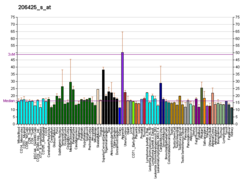Short transient receptor potential channel 3 (TrpC3) also known as transient receptor protein 3 (TRP-3) is a protein that in humans is encoded by the TRPC3 gene. The TRPC3/6/7 subfamily are implicated in the regulation of vascular tone, cell growth, proliferation and pathological hypertrophy.[5] These are diacylglycerol-sensitive cation channels known to regulate intracellular calcium via activation of the phospholipase C (PLC) pathway and/or by sensing Ca2+ store depletion.[6] Together, their role in calcium homeostasis has made them potential therapeutic targets for a variety of central and peripheral pathologies.[7]
- ^ a b c GRCh38: Ensembl release 89: ENSG00000138741 – Ensembl, May 2017
- ^ a b c GRCm38: Ensembl release 89: ENSMUSG00000027716 – Ensembl, May 2017
- ^ "Human PubMed Reference:". National Center for Biotechnology Information, U.S. National Library of Medicine.
- ^ "Mouse PubMed Reference:". National Center for Biotechnology Information, U.S. National Library of Medicine.
- ^ Xu X, Lozinskaya I, Costell M, Lin Z, Ball JA, Bernard R, Behm DJ, Marino JP, Schnackenberg CG (2013-01-29). "Characterization of Small Molecule TRPC3 and TRPC6 agonist and Antagonists". Biophysical Journal. 104 (2, Supplement 1): 454a. Bibcode:2013BpJ...104..454X. doi:10.1016/j.bpj.2012.11.2513.
- ^ Fusco FR, Martorana A, Giampà C, De March Z, Vacca F, Tozzi A, Longone P, Piccirilli S, Paolucci S, Sancesario G, Mercuri NB, Bernardi G (July 2004). "Cellular localization of TRPC3 channel in rat brain: preferential distribution to oligodendrocytes". Neuroscience Letters. 365 (2): 137–42. doi:10.1016/j.neulet.2004.04.070. PMID 15245795. S2CID 27636840.
- ^ Kaneko Y, Szallasi A (2013-01-01). "TRP channels as therapeutic targets". Current Topics in Medicinal Chemistry. 13 (3): 241–3. doi:10.2174/1568026611313030001. PMID 23432057.





